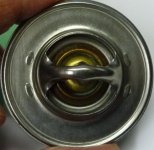I think I have made progress in stabilizing the engine temperature in my BN7 following suggestions made on this forum. To recapitulate, my car's temp gauge moved above 200F at sustained speeds around 65 mph in 80 degree weather. This car is running a six-bladed fan (I think) with fiberglass blades. When I checked to see what thermostat was installed and found none present, I pulled the radiator and took it to a shop. It was recored with a core the proprietor said would flow a great deal more coolant. Still running without a thermostat, I soon found the car creeping above 200 degrees in 80-plus weather. I confirmed that temperature with a hand-held temperature gun (infrared laser?). The header tank read 203 degrees. That was pretty disappointing, as I was expecting the radiator upgrade would bring a much lower temperature. I have now purchased and installed the Moss thermostat blanking sleeve, part number 434-135, $15.95. This is simply a short brass tube with three or four small (bleed) holes drilled in its circumference. The top is slightly swelled to engage the grooves in the head normally occupied by the rim of a thermostat. Moss said this device was designed for Healey race engines, and the objective is to blank off a port in the head that allows some coolant to recirculate back through the engine without going going through the radiator. That port is visible inside the head with the thermostat removed. I then fabricated a four-inch-wide fan shroud from sheet aluminum that runs around the sides and top of the radiator perimeter--I actually made this out of two pieces that overlap under the red-painted protective guard on the fan side of the radiator. I don't own a sheet metal break, so I clamped my work piece between two straight boards to put a 1/4" roll on both edges of the 4"-wide side pieces to give them more strength and to eliminate raw edges. This took part of the afternoon. Yesterday I took the car for a good run with the temperature just above 90 degrees. Eventually the temp gauge reached 190 degrees and stabilized there. I think that is a good working temperature, and I think those two "upgrades" may resolve my engine temperature issue. In retrospect, I wish I had tried running the car with just one of the "fixes" to get a feel for which was most significant. I'm in Florida and my fellow Healey owners commonly run their cars without thermostats and and with the heaters valved off. If I were up north, I would probably do what another forum members recommended, cutting the thermostat rim's seat in the head s bit deeper so that I could mount a normal thermostat atop the Moss-sourced blanking sleeve. The alternative, of course, is purchasing the very pricey original-type thermostats that have a sleeve sround the bottom of the thermostat. Happy to offer this to the seemingly endless discussion of Healey engine temperature issues.

 Hey there Guest!
Hey there Guest!
 smilie in place of the real @
smilie in place of the real @
 Pretty Please - add it to our Events forum(s) and add to the calendar! >>
Pretty Please - add it to our Events forum(s) and add to the calendar! >> 





 A friendly reminder - be careful what links you click on here. If a link is posted by someone you don't know, or the URL looks fishy, DON'T CLICK. Spammers sometimes post links that lead to sites that can infect your computer, so be mindful what you click.
A friendly reminder - be careful what links you click on here. If a link is posted by someone you don't know, or the URL looks fishy, DON'T CLICK. Spammers sometimes post links that lead to sites that can infect your computer, so be mindful what you click.